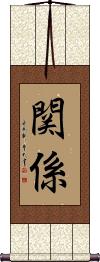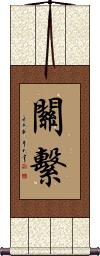Many custom options...
And formats...

関係 in Chinese / Japanese...
Buy an 関係 calligraphy wall scroll here!
Personalize your custom “関係” project by clicking the button next to your favorite “関係” title below...
Relationship
Most common Japanese version
The dictionary definition is:
relation, relationship, connection, participation, involvement, concern, influence, effect, related to, connected to, or as a suffix to sexual it can mean sexual relations or relationship.
But there's more to it...
In Japan, the relationship that you have with certain people can open doors for you. Having this relationship with someone also means they would never rip you off but instead are honor-bound to treat you fairly.
See our Chinese Guanxi entry for more information. This term is used in very similar ways in China, Japan, and Korea.
Guanxi
The Chinese Concept of Relationship and Exchange of Favors
The dictionary definition is:
Relations/relationship, to concern, to affect, to have to do with, or connection.
But there's more to it...
In China, the relationship that you have with certain people can open doors for you. Having guanxi with someone also means they would never defraud you but are honor-bound to treat you fairly (of course, this goes both ways). Sometimes it is suggested that guanxi is the exchange of favors. 關繫 / 関繫 / 關係 is more about having a relationship that allows you to ask for and expect favors without shame.
There is no concept in western culture that exactly matches guanxi, but perhaps having a social or professional network is similar.
Note that there are some variations common within Chinese, Japanese Kanji, and Korean Hanja for this word... Japanese tend to use a Chinese alternate form as shown to the right for
Japanese tend to use a Chinese alternate form as shown to the right for
the first character.
 There's also another alternate form of that first character (currently used as the official Simplified form in mainland China) which looks like the character shown to the right. It's basically the central radical of the alternate version shown above but without the “door radical” around it. In more free-flowing calligraphy styles, this version would be the likely choice for a calligrapher.
There's also another alternate form of that first character (currently used as the official Simplified form in mainland China) which looks like the character shown to the right. It's basically the central radical of the alternate version shown above but without the “door radical” around it. In more free-flowing calligraphy styles, this version would be the likely choice for a calligrapher.
![]() In Modern Japanese, they use the character shown to the right.
In Modern Japanese, they use the character shown to the right.
They also tend to use this same form in Korean Hanja (I've only checked this word in my Korean dictionary, but it has not been confirmed by a translator's review).
![]() If that was not confusing enough, there is another alternate form of that second character. See right.
If that was not confusing enough, there is another alternate form of that second character. See right.
An Asian calligrapher of any nationality may use these forms at their discretion. However, They would tend to stick to the most common form used in their respective languages.
If you have any preference on any of these issues, please give us a special note with your order, and we'll make sure it's done the way you want.
Not the results for 関係 that you were looking for?
Below are some entries from our dictionary that may match your 関係 search...
| Characters If shown, 2nd row is Simp. Chinese |
Pronunciation Romanization |
Simple Dictionary Definition |
関係 see styles |
riezon りえぞん |
More info & calligraphy: Relationship |
力関係 see styles |
chikarakankei / chikarakanke ちからかんけい |
balance of power (in a relationship); power dynamic |
女関係 see styles |
onnakankei / onnakanke おんなかんけい |
relations with women |
無関係 see styles |
mukankei / mukanke むかんけい |
(adj-na,adj-no,n) unrelated |
関係先 see styles |
kankeisaki / kankesaki かんけいさき |
affiliate; related party |
関係図 see styles |
kankeizu / kankezu かんけいず |
(See 相関図・2) relationship chart |
関係式 see styles |
kankeishiki / kankeshiki かんけいしき |
{math} relational expression |
関係性 see styles |
kankeisei / kankese かんけいせい |
relationship; relation |
関係筋 see styles |
kankeisuji / kankesuji かんけいすじ |
relevant source; well-informed source; interested parties |
関係節 see styles |
kankeisetsu / kankesetsu かんけいせつ |
{gramm} relative clause |
関係者 see styles |
kankeisha / kankesha かんけいしゃ |
person concerned; people involved (in an event); those concerned; staff |
関係詞 see styles |
kankeishi / kankeshi かんけいし |
{gramm} relative |
関係調 see styles |
kankeichou / kankecho かんけいちょう |
{music} relative key |
三角関係 see styles |
sankakukankei / sankakukanke さんかくかんけい |
love triangle; eternal triangle |
上下関係 see styles |
jougekankei / jogekanke じょうげかんけい |
pecking order; hierarchical relationship; vertical relationship; hyponymy |
両国関係 see styles |
ryoukokukankei / ryokokukanke りょうこくかんけい |
bilateral relations; relationship between two countries |
両岸関係 see styles |
ryougankankei / ryogankanke りょうがんかんけい |
cross-strait relations; relations between mainland China and Taiwan |
主従関係 see styles |
shujuukankei / shujukanke しゅじゅうかんけい |
(1) the relation of master to servant; homage; (2) {comp} master-slave relationship |
事実関係 see styles |
jijitsukankei / jijitsukanke じじつかんけい |
all facts (of a case, incident, etc.) |
互恵関係 see styles |
gokeikankei / gokekanke ごけいかんけい |
reciprocal relationship; mutually beneficial relations; relationship with benefits to both parties |
交友関係 see styles |
kouyuukankei / koyukanke こうゆうかんけい |
one's relationships; people one knows; circle of friends |
人間関係 see styles |
ningenkankei / ningenkanke にんげんかんけい |
human relations; personal relationships |
依存関係 see styles |
izonkankei / izonkanke いぞんかんけい |
dependence (relationship); dependency (relationship) |
信頼関係 see styles |
shinraikankei / shinraikanke しんらいかんけい |
relationship of mutual trust; fiduciary relation |
偏向関係 see styles |
henkoukankei / henkokanke へんこうかんけい |
{comp} bias relation |
共犯関係 see styles |
kyouhankankei / kyohankanke きょうはんかんけい |
complicity (in a crime); collusion |
内縁関係 see styles |
naienkankei / naienkanke ないえんかんけい |
(noun - becomes adjective with の) de facto marriage; common-law marriage; living together as husband and wife without formal marriage |
利害関係 see styles |
rigaikankei / rigaikanke りがいかんけい |
interests; stake |
前後関係 see styles |
zengokankei / zengokanke ぜんごかんけい |
context (of a passage) |
勢力関係 see styles |
seiryokukankei / seryokukanke せいりょくかんけい |
power relations; balance of power (between) |
Click here for more 関係 results from our dictionary
The following table may be helpful for those studying Chinese or Japanese...
| Title | Characters | Romaji (Romanized Japanese) | Various forms of Romanized Chinese | |
| Relationship | 關繫 / 関繫 / 關係 関係 | kan kei / kankei | guān xì / guan1 xi4 / guan xi / guanxi | kuan hsi / kuanhsi |
| Guanxi | 關繫 / 関繫 / 關係 关系 / 関係 | kankei | guān xì / guan1 xi4 / guan xi / guanxi | kuan hsi / kuanhsi |
| In some entries above you will see that characters have different versions above and below a line. In these cases, the characters above the line are Traditional Chinese, while the ones below are Simplified Chinese. | ||||
Successful Chinese Character and Japanese Kanji calligraphy searches within the last few hours...





